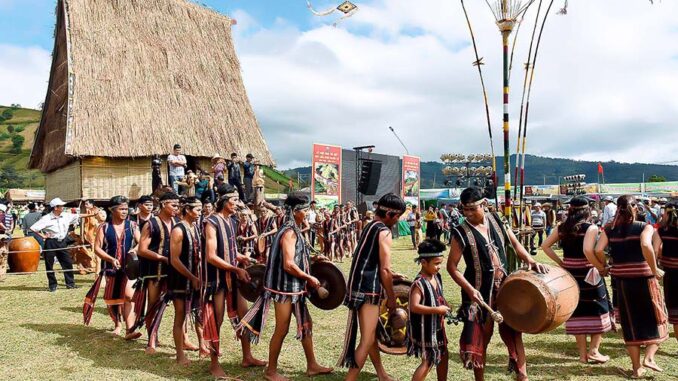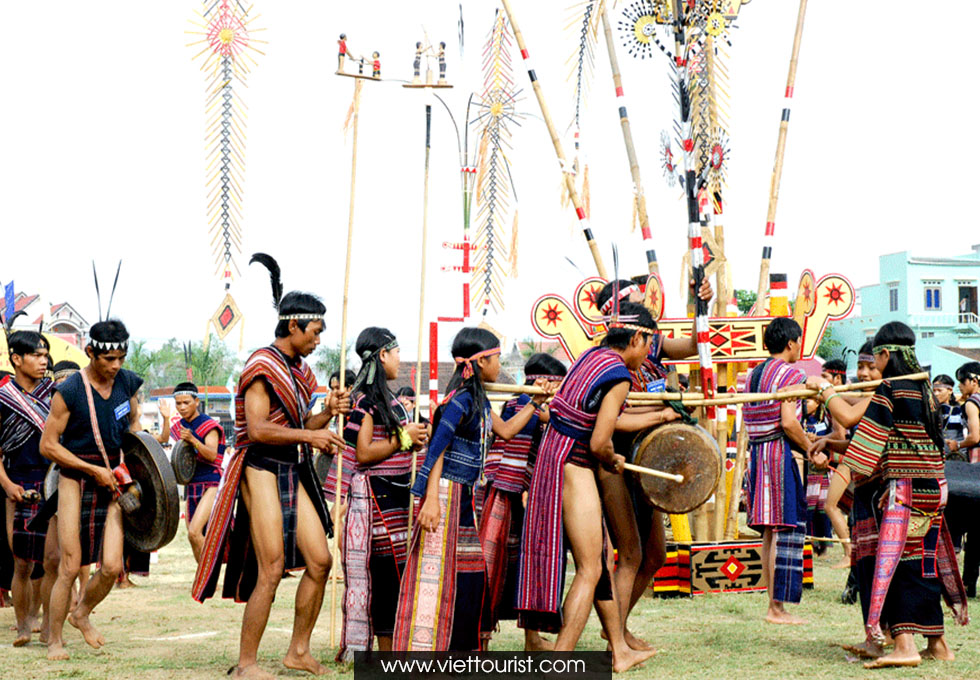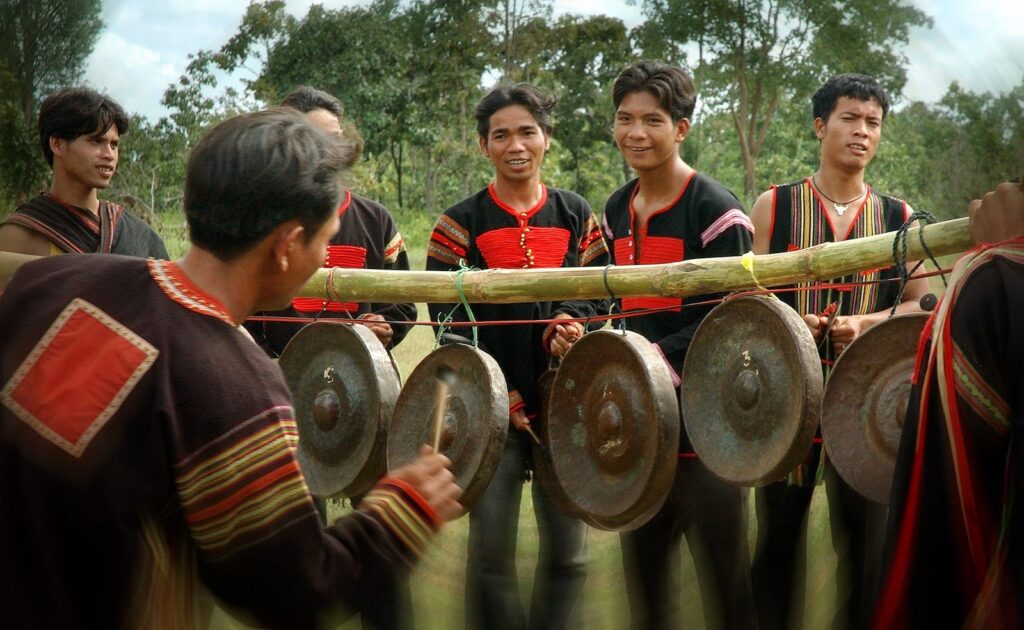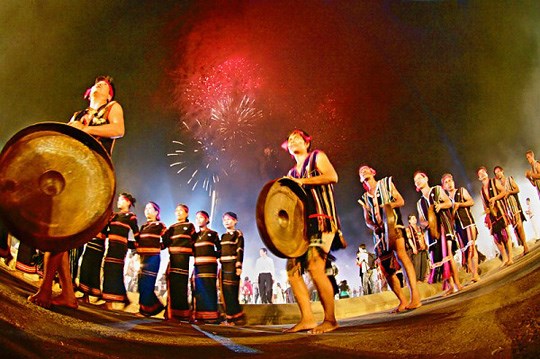
This is one of seven intangible cultural heritages of Vietnam symbolizing the wonderful and unique Vietnamese national identity. Coming to the Central Highlands, everyone wants to enjoy the deep, resonant sounds of gongs amidst the vast mountains and forests. Central Highlands gongs not only have a special appeal because of the unique diversity of performance techniques but are also a spiritual voice and a symbol of the lives of people here.
Introduce
Throughout the Central Highlands of Vietnam, Gong ensembles are parts of various ceremonies and are closely linked to the communities’ daily lives and the cycle of the seasons. The instruments, measuring 25 to 80 centimeters, are played by men as well as women.
The cultural space of the Gongs of central Vietnam is about original musical forms that are performed against the background of the linguistic and ethnic diversity of the region. Diversity is also found in the compositions and customs of the Gong ensembles, in their performance techniques, in the musical genres, and in the ritual functions of the gongs.
In the realm of Vietnam’s musical instruments, the gongs are very well-known for their outstanding value and are considered the privileged language bridging humanity and the supernatural world. The gongs are made from a mixture of bronze and silver, with some distinctive features. The people living in the Central Highlands of Vietnam possess many sets of gongs, which would be performed differently. A set of gongs consists of two to twenty units.
History
No one knows when gongs appeared on the sunny and windy land of the Central Highlands. It is like underground water that carries the breath of life for the people here. Cultural researchers believe that gongs date back to ancient times, originating from the Dong Son civilization at least 3,500-4,000 years ago, with two typical musical instruments being bronze drums and gongs. According to the beliefs of the Central Highlands people, gongs are the leading communication language of humans with the supernatural world. It is considered a representation of property, power, and safety in each family and community.

Cultural Value
The most outstanding value of gong culture is that it showcases masterpieces of human creativity. The masters of gong culture are the ethnic people of the Central Highlands. Although they cannot cast gongs themselves, they raise the value of a product into an excellent musical instrument with their sensitive ears and musical soul. In the hands of talented folk artists, each gong plays the role of a musical note in an orchestra to perform different pieces of gong music.
As for ethnic backgrounds in the Central Highlands, gongs and gong culture present a means to affirm the community and its cultural identities. As time went by, gongs became an attractive and appealing symbol of the culture of the Central Highlands. It is an activity associated with the cultural and spiritual lives and beliefs of ethnic people when they are born, grow up, and return to the soil.
Customs of Gong culture

The Central Highlands gong comes from long-standing historical and cultural traditions. In the past, the community of people in the Central Highlands knew how to play the gong. Its sound is either deep or strong, moving and combining with the sounds of streams, wind, and the hearts of people so that it can live with heaven, earth, and people in the Central Highlands. However, different ethnic minority groups arrange different orchestras.
Listening to the sound of the gong, people in the Central Highlands can tell which ethnic group is playing. Gong players in the majority of ethnic groups in the Central Highlands are male. Only in a minority of ethnic groups in the region are gong players female.
Community value
The sound of gongs is a connection to the community in a very sacred and secular way, in thoughts and togetherness. Gongs have become an indispensable symbol in the lives of the people of the Central Highlands. The sound of gongs not only evokes magical sounds but also brings an indescribable excitement to the heart of every person and creates strong solidarity in the entire nation.
The sound of gongs depicts the sobbing in the health praying ceremony, the longing for the rice paddy clearing ceremony, and the excitement and joy in the rice god festival. The Central Highlands gong cultural space is one of the heritages that needs to be preserved and promoted.
Gong festivals
On festival days, the image of people dancing around the sacred fire, next to jars of wine, while the sound of gongs echoing through the mountains and forests creates a romantic and magical space for the Central Highlands. This is also the origin of epic stories and poems that enter people’s hearts.
The Central Highlands gong is not only a symbol closely associated with the daily lives of the Central Highlands people, but it is also the voice of spirituality, the human soul, and expresses joy and sadness in working life through their movements and activities.

Conclusion
On November 25, 2005, UNESCO decided to recognize “The Cultural Space of Gong in the Central Highlands” of Vietnam as a “Masterpiece of the Oral and Intangible Cultural Heritage of Humanity”.
The fame of the Cultural Space of Gong in the Central Highlands of Vietnam has crossed national borders to become a prestigious property of human beings.
Specific values of the cultural space of the Central Highlands gong, which is part of Vietnam’s cultural heritage and essence, have been recognized by the international community.
Get an opportunity to visit Intangible World Cultural Heritage in Vietnam through Vietnam E-Visa!